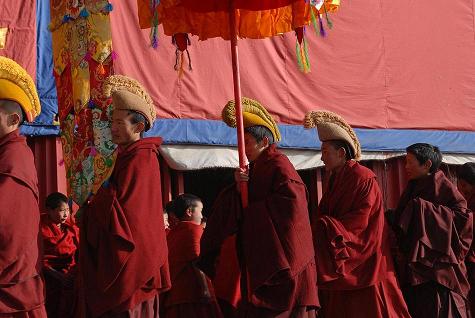

CUT001-1: Losar-Celebrations in Osttibet
Introduction Losar is the Tibetan word for "new year." Lo holds the semantic field "year, age"; sar holds the semantic field "new, fresh". Losar is the most important holiday in Tibet. Losar is celebrated for 15 days, with the main celebrations on the first three days. On the first day of Losar, a beverage called changkol is made from chhaang (a Tibetan cousin of beer). The second day of Losar is known as King's Losar (gyalpo losar). Losar is traditionally preceded by the five day practice of Vajrakilaya. Although it often falls on the same day as the Chinese New Year (sometimes with one day or occasionally with one lunar month difference), it is generally not thought to be culturally directly connected to that holiday. It is culturally more related to Tsagaan Sar in Mongolia than to the Chinese New Year festivity.
Losar-Celebrations in Osttibet Thousands of small coloured paper-sheets printed with Lugta the fortunate windhorse will be thrown into air by Serta-Golok-Nomads and from the heat of the blazing sacrifice fire carried into sky. The procession of fur coated warriors has formed up – at the top of the monastery courtyard the ritual mask dances are starting. The festivities of Losar the Tibetan New Year in Bon-monastery Nangshig have reached the peak level. Undergo five days long the religiously and profane celebrations of Tibetan New Year with pompous processions an unveiling of a large Thanka ritual mask dances as like as local customs like decollating a pile in several parts celebrated by monks police and laymen. The districts of Aba and Rangtang in the South of the holy Mt. Amnye Machen a long time are ruled by themselves like kings and sovereigns because the area was difficult to access. This was the Area of Serta Golok nomads. In earlier years they are called as robberies and Chinese caravans and other foreign travellers avoid to move there.
Day1: Beijing - Chengdu Arrival in Beijing and continuation to Chengdu the capitol of the province Sichuan. Chengdu is known of “rice storage of China” and home of the Panda.
Day2: Chengdu - Rilong On our trip into the Tibetan highlands first we reach the famous irrigation plant of Dujiang Yan from 256 B. C. close to Guanxian (58 Km). We walk around the wide-stretched temple complex of the Two Kings (Erwang Miao) with different temples and pavilions down to the Alan suspension bridge (Alan Qiao) wich overdraw the Min river. We go further into the cramped gorge of Wolong nature preserve (90 Km) one of the greatest Biological research centres for Pandas. Along the research centre we drive up the the Balang Shan pass (4500 m) and reach Rilong (3500m).
Day4: Rilong - Danba From Rilong we go down the copious valley of Xiaojin river and passes many small Tibetan villages. Passing Xiaojin we reach Danba (1900 m). At once we go into Suopo village wich is only in a distsance of 3 Km and is called “Land of Thousand Watch towers”. In this area of Gyarong- and Minyak Tibetans there are many villages with farm houses build with stones. After lunch we go up a small mountain road to Jiaju village. We walk around the village and try to visit families in their.
Day5: Danba - Rangtang Today distance from Danba to Rangtang is 316 Km. 30 Km before Rangtang close the road we visit a Kargyüpa monastery named Sirin Kar wich emblems are the four nine storied “Towers of Milarepa”. Driven distance 316 Km.
Day6: Rangtang - Aba From Rangtang we drive over the Garka La (3950 m) down to Dzi Chu river valley. We divert away from main road and reach after 18 Km the centre of Jonangpa sect, the monastery city Dzamthang Choede Cenpo. It insist on three monasteries: Choje, Tsangwa and Tsebcu Gompa. The Jonangpa sect is a branch of Sakyapa school. The name of the sect is derive from Jo(mo)nang monastery close to Lhatse in Central Tibet. After visitation and lunch we go back to main road until to the Nyingmapa monastery Bathang with its monumental Tschorten (Stupas) and a Mani wall; one part of the stones is from the year 1438. From Bathang monastery we drive until Aba.
Day7 – 11: Visitation of different monasteries The days 7 – 11 of our program are according with day 12 – 16 of the first month of the Tibetan moon calendar. Nearly all important ceremonies of the festivities take place in this period. The daily routine of each monastery is fix but the accurate timetable are rather flexibly. In order to see the most of ceremonies we will accommodate our program the actually conditions. Here are the primary monasteries we visit: Kirti gompa and Gomang Gar of the Gelugpa-school (Yellow caps); Ser Gompa from Jonangpa-school (Red caps); Nangshig Gompa from Pre Buddhist school of Bon. Festivities in the monasteries includes: - To show the people the fine dresses; - Pompously procession around the monastery - Great Thanka ceremony - Warriors and monks decollate poles at a stake - Horse procession of the warriors with coloured flags - Jamba Lankchor: to carry a Maitreya around the monastery - Ceremony with butter sculptures in front of the main prayer hall - Sacrifice fire with burning the Lungta (Windhorses) - Procession of monks and warriors - Mask or Cham dances in the monastery courtyard.
Day12: Aba – Chengdu Today we drive back from Aba to Chengdu and across several mountain passes.
Day13: Chengdu-Beijing After breakfast we will be carried to Airport. Flight to Beijing. Afternoon in Beijing is free at your disposal.
Day 14: Return journey After breakfast transfer to Beijing Airport and back flight to home.
Travel Time: Please ask us !
|
